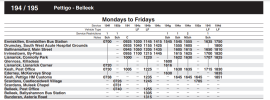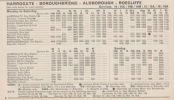Re
@GusB ‘s 33A/33C - I quite like that approach to numbering circulars (or routes with a loop for part of the journey that’s served in both directions)
It’s a bit of a shame that the new St. Andrews “Town Services” (which are either entirely or significantly loops) will be the 90/90A, the 91/91A and the 93/ 93A Rather than having “C” variants (at least the “A” services are anti-clockwise, they got that bit right)
There’s no 92 as that’s a Moffat & Williamson one which runs as 92A/ 92C on most daytime journeys around a large loop on the south bank of the River Tay - yet the other M&W services along the Gauldry-Tayport corridor are the 69/70 despite themselves going different ways round the big loop (not the 69A/69C… no consistency!
Is the use of bus route suffixes common in the UK? London no longer uses it, why did London get away with all suffixes?
My understanding is that passengers tend to prefer individual numbers to suffixes/prefixes (hence the 77A becoming the 87 in 2006; in think that this was the last TfL suffix route in central London?)
I suppose London has the blessing/curse that it has:
Long established and well used bus routes that would be hard to change because they are much more ingrained in local culture than routes in other places (you’d never see something as radical as the Glasgow Overground/Simplicity changes in London, the core of certain routes is essentially set in stone - where as many provincial places have numbers/routes vastly different to at deregulation, even if it was just a case of removing the “three hundred” at the start of the route number - places in West Yorkshire like Bradford/Wakefield are about the only major ones where local routes are still three digit - in contrast the remaining Kirkcaldy Town services become the “thirty something” next week, after originally being the eighty something then becoming generally single digit numbers with a “K” prefix then being renumbered from eleven upwards… now the ones that remain will be in the thirties - no such constant tinkering in London
Hundreds of different services all in a common numbering system, so it might not be easy to find a nearby number to use for “similar” journeys
No real need for the kind of “twice a day” diversions that some towns/cities allocate a suffix for - in London the late evening/night buses run at frequencies that make people in other parts of the UK Envious, so there’s no need to fiddle about with a few infrequent extensions a day
Such high frequency routes in the central area (at least before Johnson became Mayor/ the funding and building of Crossrail saw a lot of cuts) that coordination didn’t really matter - routes may go the same way from e.g. Kings Cross to Oxford Circus but if one is every eight minutes and the other is every ten minutes then coordination matters a lot less than a place where there are two half hourly routes which share common roads
A TfL focus on keeping things simple - around twenty years ago they were changing many “night” services to being them in line with daytime routes, rather than bearing no relation to any daytime service - Edinburgh seemed to do a lot better when their Night services similarly followed daytime routes with the same number rather than your post-clubbing bus being the “103” or “204” or whatever
Certainly in the Livingston days there was more focus on “bigger picture” stuff than hard cash - so it was better for London to have Routemasters replaced by three-doored bendy buses that soaked up passengers and kept traffic moving faster even if ticket revenue plummeted due to evasion becoming much easier, they were more more focused on keeping London moving than the kind of pressures that commercial operators have to follow elsewhere in the UK - feels like a luxury now when every penny counts but adding additional parallel services/ increasing the PVR every time a route was retendered etc seemed to become the norm for a while
Doesn't London even have a route which share the majority of common sections with only minor deviations, and works on combined schedule?
There was a trend - mainly in the Ken Livingston days (when bus funding went up BIG time, and TfL were very focused on removing “part journeys” - so would rather have two shorter routes where everything ran to the truncated terminus than one long route but nothing actually made the full journey from west to east or at least maybe only a handful of evening/Sunday trips) - to cut routes up and run overlapping services, but these new routes had unrelated numbers, e.g. the far end of the 73 (Seven Sisters) was served/replaced by a new route but I think that this was something like the 390 (not 73A or 74 or anything that would help you guess it was related to the 73) - just like the western side of the 73 became the 10 instead many years earlier
both the Seven Sisters route and Hammersmith one overlapped with the traditional 73 route quite a bit (e.g. the 10 running from Kings Cross to somewhere in the West End on the same route as the 73)
With so many route numbers taken it must be hard to find similar ones for setting up new routes like these, presumably it was quite a while ago that the “68” corridor became something like the 68/ 168/ 268/ 368/ 468/ X68 - which provided different overlapping sections of a general north-south route
In the UK outside of London, which route has the most variations with a suffix? For examples, letters A, B, C are common to be used for variations of a base route, and the letter X for express route, how about the others? Are there many uses of the letter H (hospital), M (metro), P (peak hour), R (recreational / racecourse), S (special / school) or U (university)? Are there any routes with variations sequentially lettered from A to G or beyond?
From memory, Birmingham and Dundee both used to use a few letters to denote things like “terminate at the bus depot” or “terminates short in city centre”, that kind of thing
First’s “one” corridor in Glasgow sounds like something you’d be interested in (there’s also the X4 which could probably be renumbered something like “1F” but it became the X4 as it essentially replaces services on the far north/west end of the old 44 corridor but via a faster route into the city centre)
Similarly, look at the 38 corridor in Glasgow


